Samaaro + Your CRM: Zero Integration Fee for Annual Sign-Ups Until 30 June, 2025
- 00Days
- 00Hrs
- 00Min
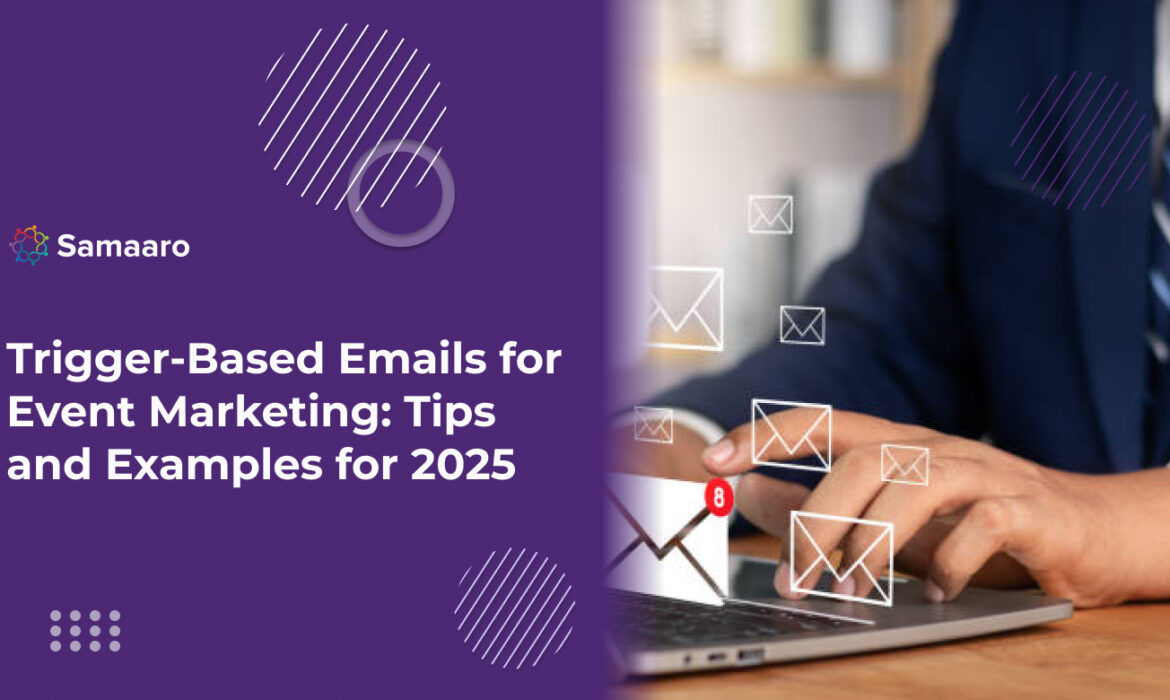
In the realm of event marketing, email is still a key strategy for engaging attendees, increasing registrations, and delivering a great experience for attendees. As we enter 2025, we will see the prominent use of trigger-based emails by marketers to communicate with their audience. Trigger-based emails are automated, action-based emails, that will allow your emails to reach the right people at the right times, which will improve productivity and results.
This guide discusses the basics of trigger-based emails, offering tips and examples to help you succeed in using a strong marketing tactic.
Trigger-based emails are an email marketing strategy that utilizes automation to deliver very targeted and personalized emails. Trigger-based emails are sent automatically based on certain actions, activities, or rules you define, helping to ensure the emails are relevant and meaningful to recipients. Triggered emails are a step above a traditional email blast that sends the same messaging to a long list of attendees with no real focus. Auto-actioned emails are specific and contextual, which empowers the deliverability of the action.
Trigger-based emails function by tracking user’s interactions or any other milestone with the appropriate output. For example:
The beauty of trigger-based emails lies in their alignment with the recipient’s journey. Here’s why they stand out:
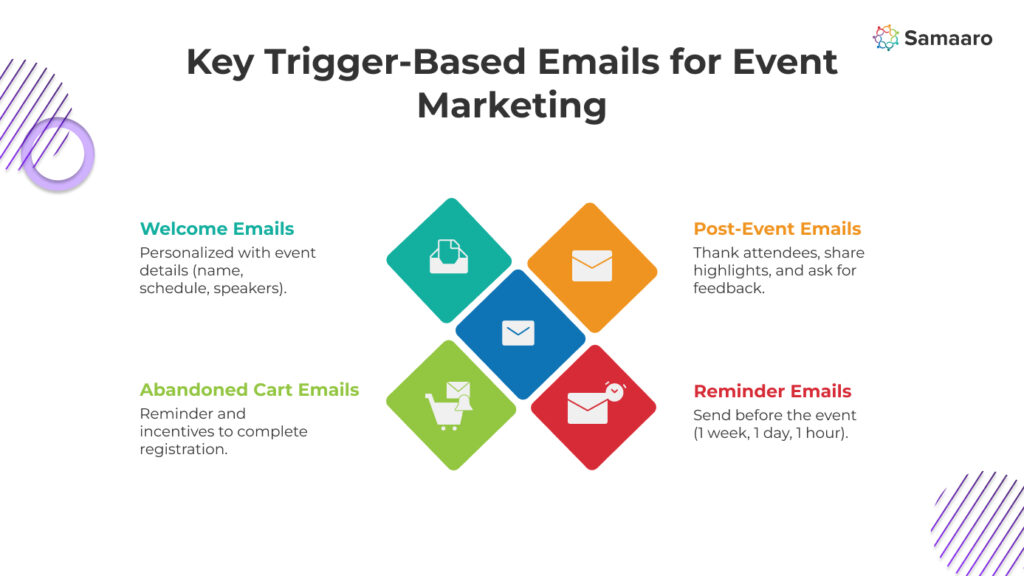
To illustrate their potential, here are some practical examples:
In the dynamic world of events, timing and communication are critical to success. Trigger-based emails ensure that every touchpoint, from registration to post-event follow-up, is strategically aligned with the attendee’s needs. Whether boosting registrations, reducing cart abandonment, or fostering post-event loyalty, trigger-based emails are a vital tool in any event marketer’s arsenal.
By leveraging trigger-based emails, you can transform your email marketing strategy into a personalized, automated, and highly efficient system that builds stronger connections with your audience while driving measurable results.
Welcome emails play a vital role in setting expectations and providing attendees with the information they need to start their event journey. They establish a positive first impression and ensure attendees feel valued.
When Triggered: Upon registration or ticket purchase.
What to Include:
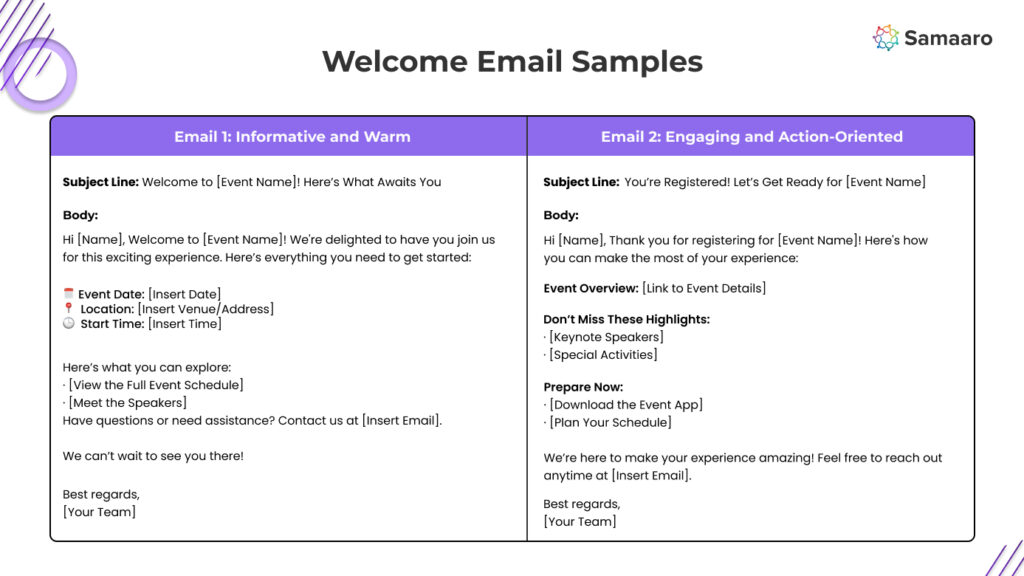
Cart abandonment emails are a gentle nudge to remind potential attendees to complete their ticket purchase. These emails should highlight the value of the event and create urgency to encourage action.
When Triggered: When a user leaves items in their shopping cart without completing registration.
What to Include:
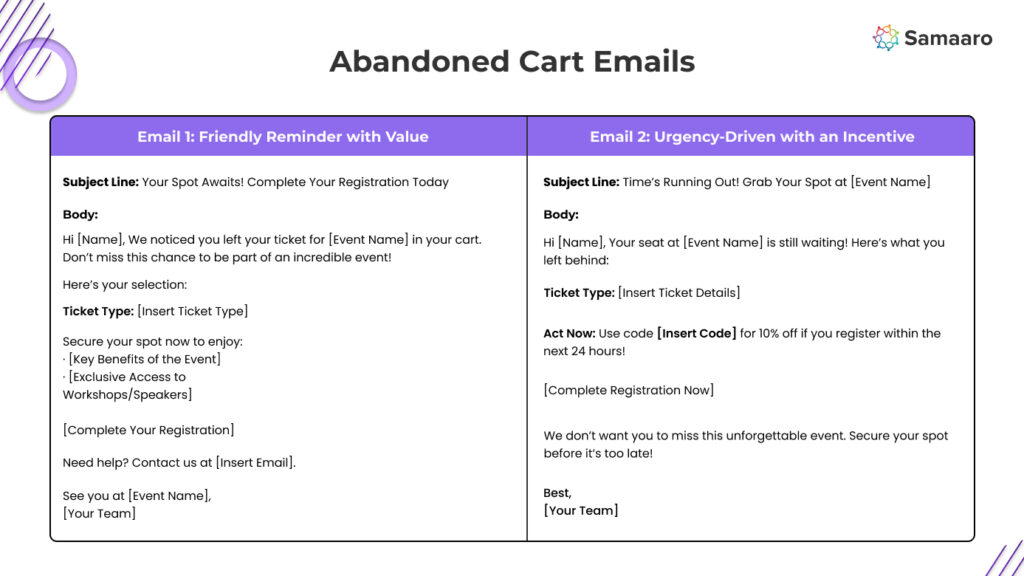
Reminder emails keep attendees informed and excited as the event approaches. These emails ensure attendees are well-prepared and don’t miss out.
When to send: 1 week, 1 day, and 1 hour before the event.
What to Include:
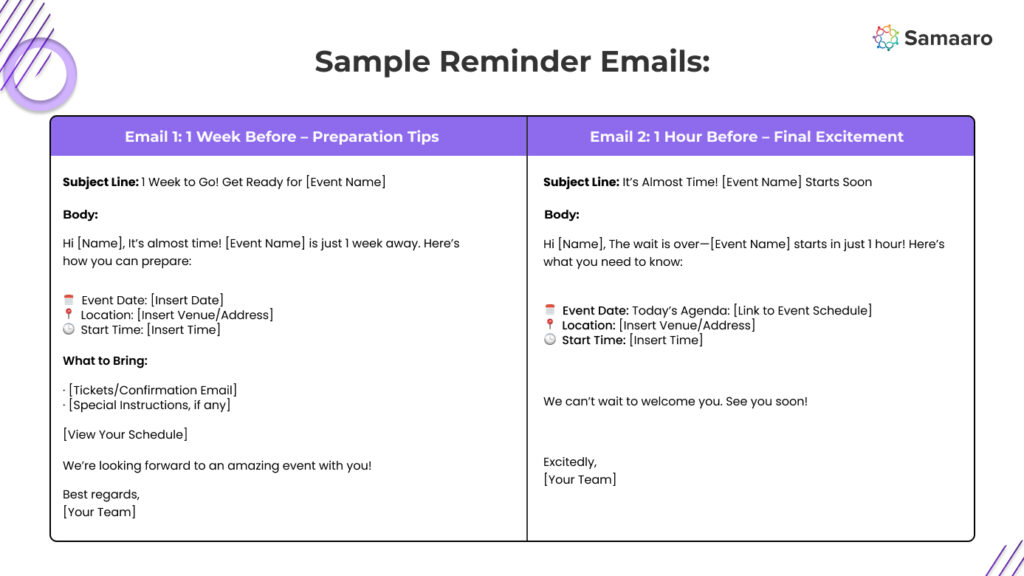
Post-event emails allow you to thank attendees, share highlights, and gather valuable feedback. They’re also an excellent opportunity to nurture relationships and promote future events.
When to send: Within 24–48 hours after the event.
What to Include:
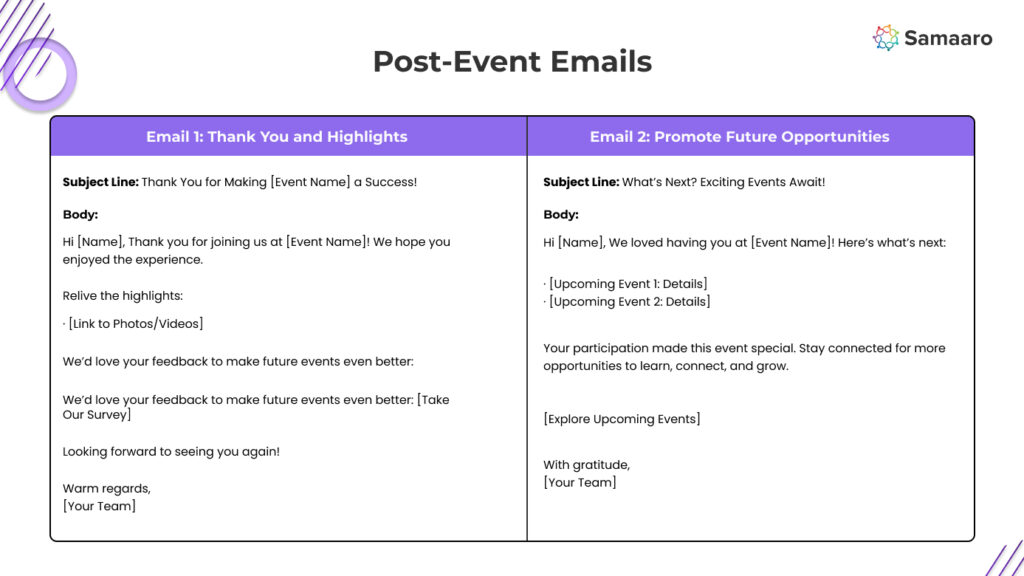
These trigger-based emails not only enhance the attendee experience but also ensure effective engagement throughout the event lifecycle.
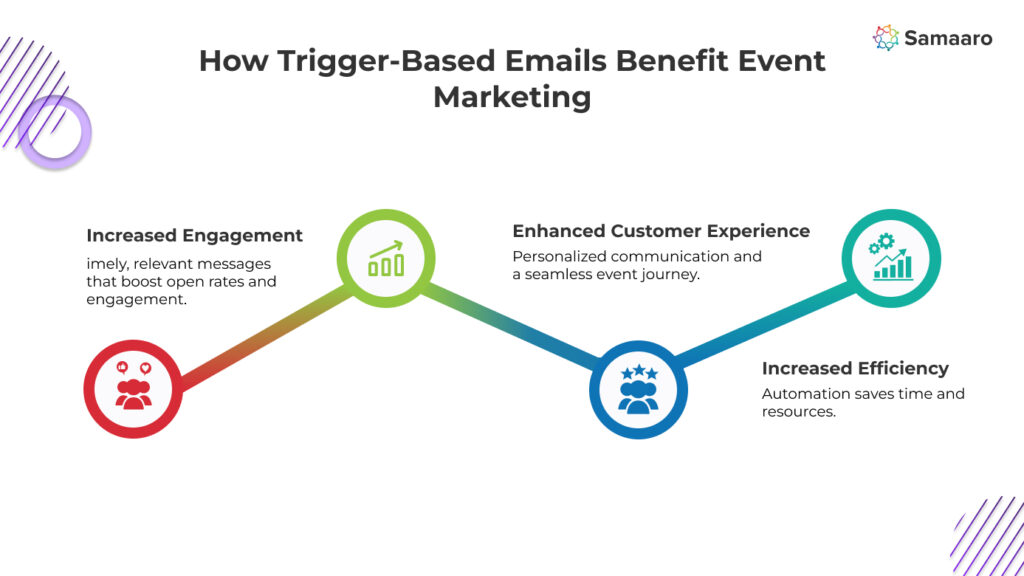
Trigger-based emails offer a range of advantages that make them indispensable for event marketers. Let’s dive deeper into their benefits:
One of the standout benefits of trigger-based emails is their ability to capture attention. These emails are sent in response to specific actions or behaviors, ensuring the message feels relevant to the recipient. When attendees receive an email shortly after registering, leaving their cart, or completing another action, they are more likely to open and engage with it.
How It Helps:
Trigger-based emails are a powerful tool for driving conversions. For instance, abandoned cart emails serve as a gentle reminder for prospective attendees who didn’t complete their ticket purchase. By addressing potential barriers—like confusion about pricing or last-minute hesitation—and offering solutions like discounts or extra perks, these emails help secure registrations that might otherwise be lost.
How It Helps:
Timely and personalized communication makes attendees feel valued. For example, a welcome email with all the essential details ensures attendees are well-prepared for the event. Similarly, a post-event email that thanks participants and shares highlights fosters a sense of appreciation and belonging.
How It Helps:
How It Helps:
Trigger-based emails rely on automation, which means your team can focus on higher-value tasks instead of manual follow-ups. Once workflows are set up, emails are sent automatically based on predefined triggers, ensuring consistent communication without extra effort.
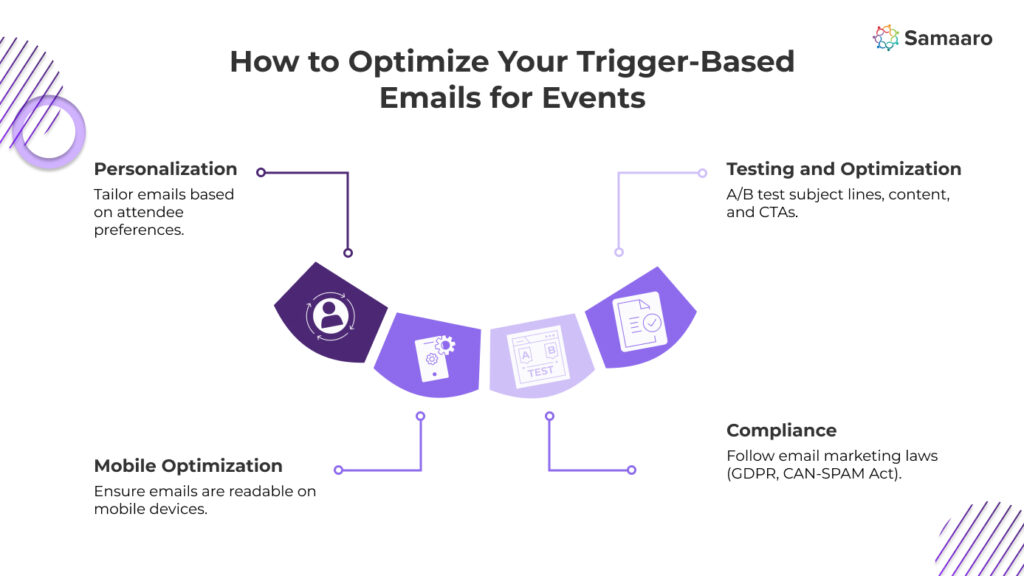
To maximize the effectiveness of trigger-based emails, it’s important to follow these best practices:
Personalization goes beyond adding the recipient’s name to an email. Leverage data to tailor the content to individual preferences and actions. For instance, include the specific ticket type they purchased or recommend sessions based on their interests.
Tips for Personalization:
In today’s mobile-first world, many recipients will open emails on their smartphones. If your emails aren’t optimized for mobile, you risk losing engagement and conversions.
How to Optimize for Mobile:
A/B testing is essential for refining your email campaigns. Experiment with different elements like subject lines, email layouts, imagery, and CTAs to identify what resonates best with your audience.
Testing Ideas:
Respecting privacy and adhering to email marketing regulations is critical. Failure to comply can lead to penalties and harm your brand reputation.
Key Compliance Tips:
Trigger-based emails are a game-changer in event marketing. Unlike traditional email campaigns, they are highly targeted, personalized, and action-driven, ensuring your audience receives the right message at the right time. From welcoming attendees to keeping them engaged post-event, these emails help marketers streamline communication and create a seamless attendee experience.
Why They Matter:
Get Started Today:
By implementing trigger-based email campaigns, you can elevate your event marketing strategy in 2025. Whether you’re a seasoned marketer or just getting started, platforms like Samaaro can help automate and personalize these campaigns, ensuring your event communication is both efficient and impactful.
Ready to transform your email marketing strategy? Dive into the world of trigger-based emails and watch your events thrive!
Connect with Samaaro today—book a demo or start your free trial to experience how our platform can help you craft and send personalized, automated trigger-based emails for your events.

Built for modern marketing teams, Samaaro’s AI-powered event-tech platform helps you run events more efficiently, reduce manual work, engage attendees, capture qualified leads and gain real-time visibility into your events’ performance.
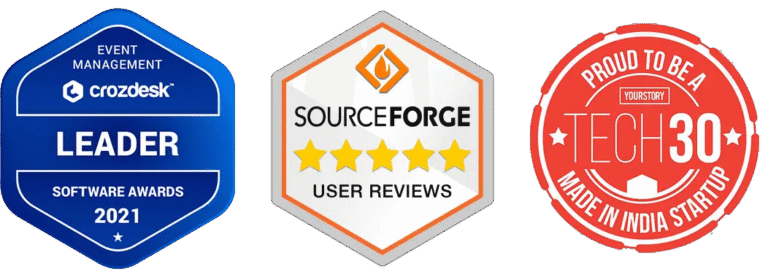
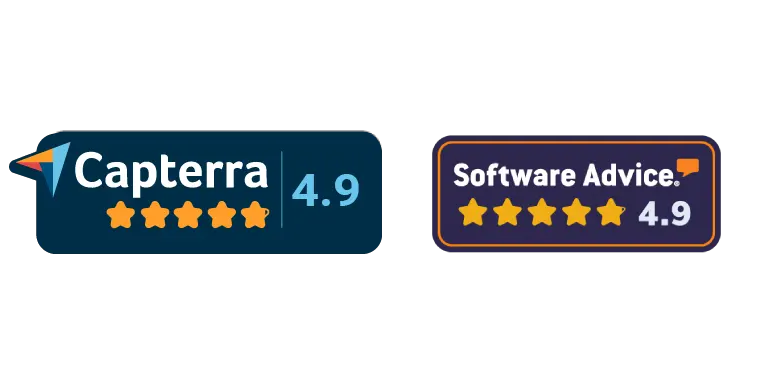
© 2025 — Samaaro. All Rights Reserved.